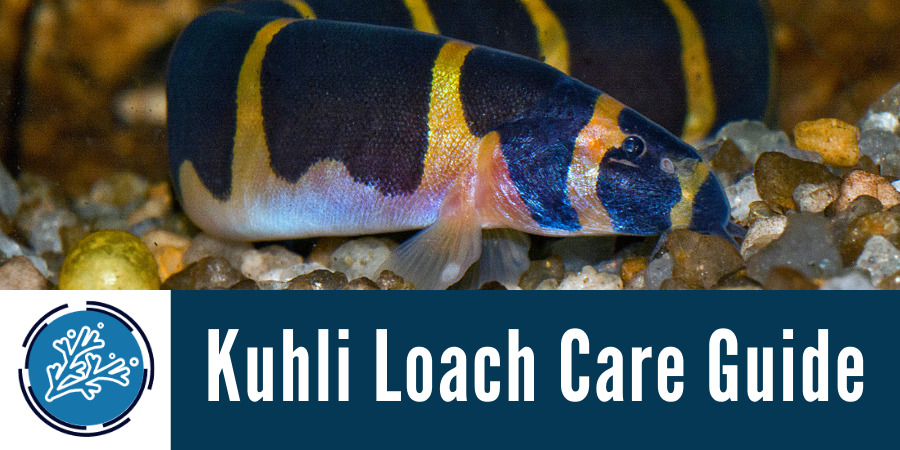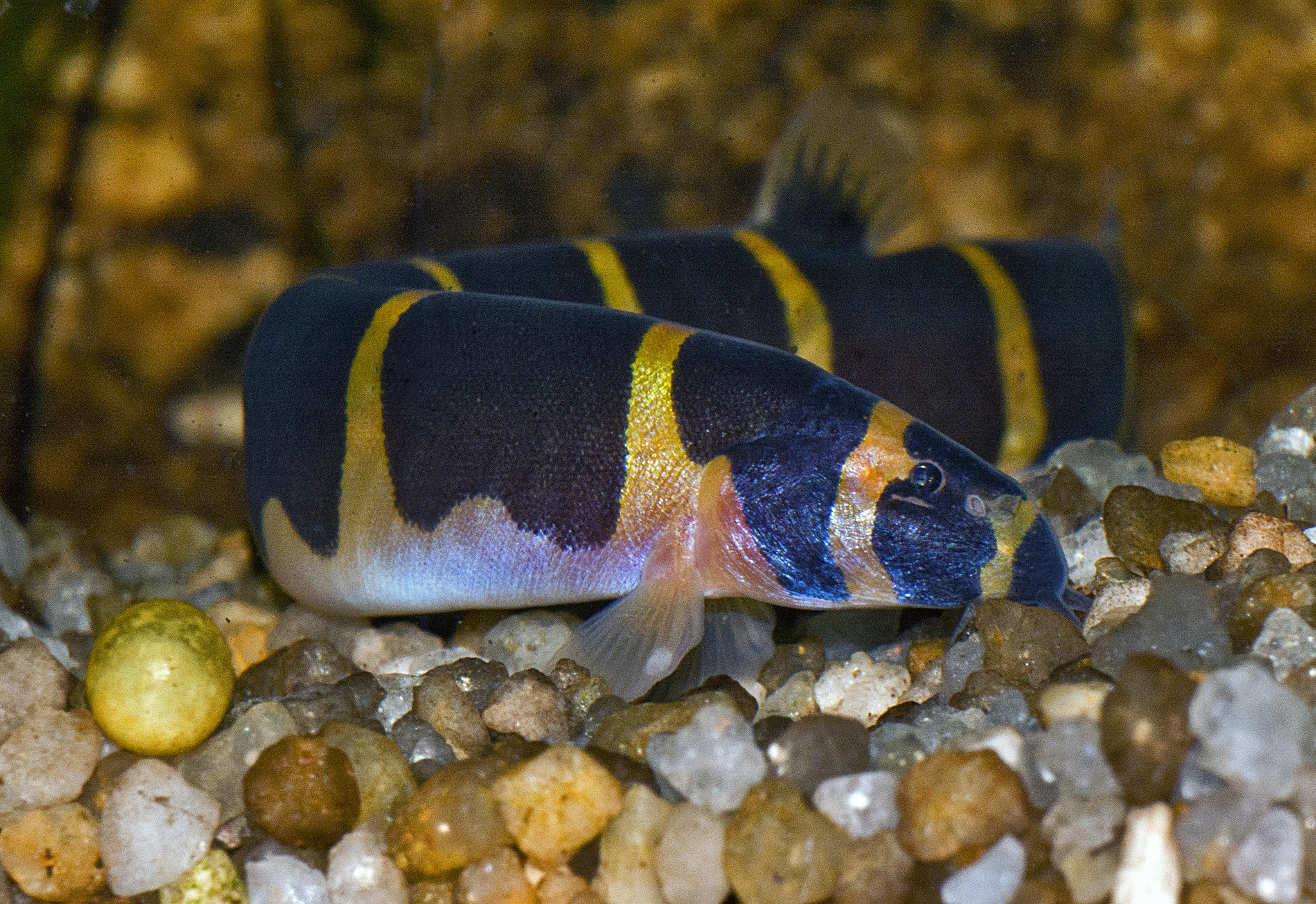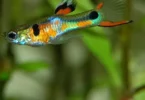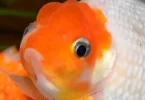Last Updated on February 10, 2023 by Matt
The Kuhli loach is a bottom dwelling eel-like freshwater fish that belongs to the Cobitidae family along with many other loaches. Also known as the Coolie or Leopard loach, Kuhli Loaches originate from Southeast Asia and inhabit the streams of Thailand, Sumatra, Singapore, Borneo, and western Malaysia. In the wild they are most commonly seen in slow-moving rivers and clean streams around mountains where they live in small groups.
Kuhli loaches love burrowing in the substrate and exploring around an aquarium and can be quite social when interacting with other loaches. These fish are nocturnal and are most active at twilight and during the night both in the wild and in captivity.
Kuhli loaches are incredible additions to an aquarium with their intriguing markings and impeccable behaviour within the tank towards other fish. They are peaceful natured and are often described as water owls due to their characteristics and nocturnal habits, they thrive best when housed with other Kuhli loaches as they can become shy when housed alone. These loaches are scavengers and will be found foraging around your tank consuming hidden pieces of food from the substrate and through the plants. They can live for around 10 years when kept in the correct conditions and are not put in any harmful or stressful situations.

IN THIS ARTICLE
Kuhli Loach Care Summary
Kuhli Loach Care Summary | |
| Family | Cobitidae |
| Care level | Intermediate |
| Temperament | Peaceful |
| Lifespan | 10 years |
| Size | 3-5 inches |
| Color | Yellow/pink with brown striped |
| Diet | Omnivore |
| Minimum tank size | 20 gallons |
| pH levels | 5.5 – 6.5 |
| Water hardness | 0-5 dGH |
| Temperature range | 73-86℉ (23℃ – 30℃) |
| Compatibility | Small group of Kuhli loach and other peaceful fish |
| Tank set up | Freshwater planted tank |
Appearance
Kuhli loaches have eel-like shaped bodies and don’t grow much more than 3-5 inches long. They are pink/yellow in color with 10-15 brown striped markings covering their entire bodies, the pattern type varies between the subspecies. A Kuhli loach has small fins with the dorsal fin located closer to the tail than the head, their eyes are located under one of the stripes and are covered with a thin layer of transparent skin.
Like the clown loach, Kuhli loaches also have sharp spines below the eye that come out when they feel threatened, and these can also be used on humans, so ensure you are educated on how to correctly handle your loach before doing so, as they may cause you harm. The Kuhli loach has a downward facing mouth due to them being bottom feeders to collect food on the substrate; their mouths are then completed with four pairs of barbels that help them navigate their way to food.
The only difference between male and female Kuhli loaches is that males have a bigger dorsal fin than females and a more defined and muscular dorsal cross-section.
Even though Kuhli loaches are peaceful and pretty easy to care for in terms of housing requirements, they are still more suitable for experienced fish owners due to their susceptibility to diseases. As these loaches do not have head scales, and very faint body scales, they are much more vulnerable to diseases and will be the first ones to show signs of disease if it occurs in your tank. They can also be very sensitive to medications, so in order to keep these loaches healthy, you should be knowledgeable in their care needs.
Housing

Credit: AJC1 (Flickr)
Regarding tank size, a 20-gallon tank is the minimum they should be housed in for a small group of 5-6, this will give them enough space to roam around the enclosure and not be too overcrowded. Kuhli loaches are not necessarily schooling fish that will stay in their group constantly, however they are definitely more comfortable and confident in their environment when they are housed together. Therefore, if you want your Kuhli loach to be more active and social, having a group will increase this. Having one Kuhli loach may not affect its well-being, however it will hide away most of the time and will only come out occasionally during the night; having a group of Kuhli loaches will really allow them to thrive in your aquarium.
These loaches are known to be escape artists through their unusual body shape, and have sometimes been seen to jump out of their tank when under threat or feeling stressed, so it is best to house them in a tank with a lid, and not an open top aquarium. The intake basket tube that removes the water from the aquarium also needs to be covered with a filter sponge as Kuhli loaches will be able to get inside the tube and into the canister filter. Even though this will not harm them in any way, they will begin to starve or become extremely stressed if they are left in there for a long time. So, if you cannot provide a filter sponge, ensure that you are prepared to do a headcount on your loaches to ensure that they have remained in their enclosure.
You will want to avoid using sharp or coarse gravel for the substrate as this can result in small cuts on their barbells and sometimes on their bodies; therefore a fine substrate like sand is a more suitable substrate for them. Kuhli loaches need lots of hiding spots and foliage to explore in their enclosure, this will allow them to feel more comfortable and will encourage them to roam in the open spaces of the tank knowing that they also have the opportunity to hide when they want to. You can easily stimulate and enhance their environment by adding in litter, such as leaves, on the substrate for them to forage through and explore.
Kuhli loaches love moving through plants and pieces of wood to find food and hide. Some ideal aquarium plants for these loaches are java fern, java moss and Anubias that will grow around wood and objects in the aquarium. .
Water conditions and temperature
Kuhli loaches live well in slightly warmer water of 73-86 degrees Fahrenheit, this is due to them living in tropical slow-moving rivers in the wild where the water is heated by the sun throughout the day. Lower temperatures can also be an invitation for diseases and parasites to occur in your aquarium, which can be fatal to Kuhli loaches. To maintain the warmer temperature in your aquarium you need to install an aquarium heater, this will heat the water to your desired temperature and keep it consistent throughout the day. Submersible heaters can be attached to the glass at the back of the tank, or alternatively you can have an in-line heater installed into the external filter which heats up the water as it travels back into the aquarium – see our best aquarium heaters article. If the heater does not include a thermometer, it is important to include a small separate one the place on the side of the tank to monitor the temperature – see our best aquarium thermometers article.
External, internal and under-gravel filters are all suitable for a Kuhli loach aquarium to keep the water clean, however these do depend on the size of the tank. Internal filters are more suitable for smaller tanks, so this will be ideal for 2-3 Kuhli loaches in a 10-gallon tank. For bigger tanks an external filter will be more suitable, however for Kuhli loaches specifically, under-gravel filters are the best option. Under-gravel filters lay underneath the substrate and help to improve oxygenation and to reduce waste, they are also more aesthetically pleasing as there are no external parts that are visible, it only requires see through tubes on either side of the tank.
These loaches require a lower pH of around 5.5-6.5 as they originate from slightly more acidic waters than other fish. However, many fish keepers have kept Kuhli loaches at a neutral pH of 7-7.5 and have not experienced any problems. The water should be soft with a water hardness of 0-5 dGH. To monitor the chemicals, present in the water and to ensure the water parameters are at the correct level that your Kuhli loaches require, you will need to test the water occasionally. We always recommend the same two testers, as they are the most reliable:
Aquarium test strips:
These water test strips are a quick and easy alternative to the master test chemical kits, complete with four
strips and a chemical chart. One of these strips is to be placed into the water for a short amount of time and the colors on the strip should then be compared to the color chart – this will then accurately tell you the levels of pH, nitrite, nitrate, carbonate and general water hardness.
Master test kit:
- Contains one (1) API FRESHWATER MASTER TEST KIT 800-Test Freshwater Aquarium Water Master Test Kit, including 7 bottles of testing solutions, 1 color card and 4 tubes with cap
- Helps monitor water quality and prevent invisible water problems that can be harmful to fish and cause fish loss
- Accurately monitors 5 most vital water parameters levels in freshwater aquariums: pH, high range pH, ammonia, nitrite, nitrate
- Designed for use in freshwater aquariums only
- Use for weekly monitoring and when water or fish problems appear
This master kit is a more advanced alternative to the testing strips, with 7 bottles of testing solutions, 1 color card and 4 glass tubes. This kit will measure the pH, high range pH, ammonia, nitrite and nitrate, this kit may give you a more accurate result, however there is more of a risk of disrupting the process by putting too many or too little drops in the test tubes.
Feeding and Diet
Kuhli loaches are omnivorous fish that eat small crustaceans, larvae, and plant matter that they find on the bottom of both captive aquariums and in the wild on the riverbed. Kuhli loach do not hunt for their food, instead they forage through the substrate until they come across any particles that they can consume.
They have a pretty low bioload, meaning that they are scavengers and will not eat high amounts of food in one day, they prefer to forage around for left over food at the bottom of the tank; however, they are still required to be fed. As Kuhli loach are bottom dwellers, they are also bottom feeders, so they should be fed foods that sink quickly as this prevents any other fish getting to it first. Kuhli loaches are not picky eaters and will consume various foods given to them, however as they are nocturnal they are more likely to eat the foods when the lights are turned off. So it is best to feed your Kuhli loach later in the day or early in the morning for a higher chance of them eating the food, doing this will ensure they grow to a good size and become well nourished. Feeding them in the day will also cause the food to rot and waste away into the water causing more algae to form and the water to require a clean and water change more frequently.
Food provided to them can include sinking pellets, bloodworms or sinking wafers, however they do generally prefer meat-based food. A balanced diet should consist of live food such as Bloodworms, Daphnia, Artemia and Micro worms, and also provide them with pellets or vegetables. To find our recommended fish foods for bottom feeders, see our article on what to feed your tropical fish.
Tank mates
The first important thing to know before choosing any other tank mates for a Kuhli loach is that they prefer to be in groups, a minimum of 5-6 in one tank; but they will thrive in a larger group. Like most loaches, Kuhli loaches are relatively shy and will hide away for most of the day, however the more Kuhli loaches you house together the more you will see them foraging around the tank. Even though they are nocturnal, they are occasionally seen throughout the day.
Kuhli loaches are peaceful fish and are never seen harassing or bothering any of their tank mates, so it is best to house them with other calm natured fish, usually any community fish such as Tetras, Corydoras, Guppies, Danios and Rasboras. They will live well with any top and middle dwelling fish that are not territorial or too intrigued by the loaches, you do not want any fish that will nip or harass your Kuhli loaches. Even fish like Betta fish live well with Kuhli Loaches, although they can be territorial. They are in our list of betta fish tank mates.
Tank mates to avoid would be anything large enough to eat them, or anything that is territorial. Cichlids, such as angelfish and Discus fish, and also Arowanas can get very large and may try to see off your loaches. Other fish such as, Blue Gourami’s and Red-Tailed sharks do not make great Kuhli loach companions as they can become territorial. Tiger barbs and Chinese algae eaters are known to nip and bully other fish, so these should also be avoided.
Enrichment
As Kuhli loaches are bottom dwellers and are constantly foraging through the substrate, they do well in an enclosure that has various hides, rocks, plants and other objects to explore. Kuhli loaches are not particularly playful, however they are still relatively social in their enclosure and can thrive off of various enrichment strategies to make their enrichment new and exciting.
There are several methods of enrichment, these include:
Environmental enrichment – Changing the appearance or function of the aquarium for the fish to experience a new environment. This also includes installing Aquarium LEDs into the tank.
Food enrichment – Using new foods to allow them to use different feeding methods.
Social enrichment – Adding compatible species to the aquarium to give the fish company and new interactions.
Regarding enrichment, these loaches will benefit the most from environmental and food enrichment. Kuhli loaches love exploring their enclosure and a great way to give them a new experience is to change and add in some new features. This can include rocks, new plant species, hides and obstacles. A great way to do this is to include a moss plant in the aquarium, a great option being Java Moss, this plant is perfect for a Kuhli loach tank as it can withstand the higher water temperatures, is versatile with pH and water conditions and it is very easy to keep and grow. Adding rocks around the enclosure will allow the moss to grow over the rocks and create a new texture for the loaches to enjoy, this will also give them a new feeding area as food particles will nest in the moss and the loaches will forage through the moss to find it. Moss is also common in rivers and streams where the loaches are found in the wild, so this is also a great way to replicate their natural environment.
Even though Kuhli loaches are bottom dwellers, some are seen to explore the top column if there are floating plants and not too many top dwelling fish. Water spangles is a great floating plant that is easy to care for, it can thrive in a wide range of temperatures and water conditions, however it won’t do well in an aquarium that has a rapid water flow, however the majority of at home tanks usually have a gentle water flow. Water spangles also create low lighting in the aquarium which the loaches will appreciate, they are often seen exploring the floating plants and hoping to find a morsel of food.
Kuhli loaches need hiding spots in their enclosure in order for them to feel safe and secure in their environment, this can be done by piling rocks on top of each other to create holes and crevices for them to go into. However, adding in aquarium hides for this purpose can sometimes be easier, here are some hides we recommend for your Kuhli loach:
When adding aquarium features to your tank, ensure that there are no sharp pieces on the object that could harm your Kuhli loach, particularly because they have sensitive bodies. Ensure that all objects are thoroughly washed before adding them into your aquarium and check the object for any pieces of glue or manufacturing issues that have caused the object to become harmful. Any sharp pieces can be taken off with scissors or sanded down to make it safe for your loaches.
Breeding
Breeding Kuhli Loaches can be difficult; however, it is not impossible and has been done. they can be stubborn when it comes to breeding, and it requires a specific environment, however it can be achieved with patience and knowledge. The first hurdle to overcome when breeding Kuhli Loaches is knowing the difference between a male and female, which is difficult and there is virtually no difference between them. Some hobbyists have identified that male have slightly larger pectoral find than females, so this can be closely monitored to find out the sex of your Kuhli Loach. You will notice the difference between them when the females are ready to spawn, as they will grow large in size and you can sometimes notice their ovaries through their skin.
If you cannot tell which loaches are female and which are male, it is not too much of a problem as they are communal breeders and don’t need to be separated from other Kuhli Loaches in order to be bred. However, it is best to move all of the loaches into a separate breeding tank away from any other fish they are housed with, and so the eggs and adults can be separated once they are laid. Keeping them in a large group will increase the chances of spawning, these loaches also do not hit sexual maturity until they are two years old.
Recreating their natural spawning environment will encourage the process, this means shallow waters with dense vegetation. You can include various live plants, both planted and floating, females will lay their eggs in floating plants so ensure there are a wide variety. The ideal pH for breeding these loaches is 6.5, ensure you are testing the pH of the water regularly to ensure it remains at this level, the water hardness can also be lowered. Feeding the loaches live food will also encourage spawning.
If the breeding process has been successful, you will notice the female getting larger and may even see the green eggs in her belly. If this occurs, you will need to monitor them very closely as Kuhli Loaches will eat their eggs once they have hatched. The eggs will not be too hard to find in the aquarium as they are bright green in colour, once the eggs have been laid and found, remove the adult loaches and put them back into their usual tank.
The eggs take around 24 hours to hatch and can be fed on the Infusoria that will be present in the live plants. This can be supplemented with tiny brine shrimp of small bits of fish flake food; the fry should be fed regularly to aid in growth.
Common health issues
Kuhli loaches are sensitive fish when it comes to diseases, and they are susceptible to many; this is due to them having no head scales and faint body scales.
The most common disease seen in Kuhli loaches is Ick, also known as White Spot Disease. This is found in many species, but if it occurs in your aquarium, the loaches will be the first to show signs.
They can also pick up parasites more easily than other fish due to them being bottom dwellers and are constantly foraging through the substrate and any uneaten foods that may house a parasite or larvae. The main symptoms of a parasitic infection include weight loss and behavioral changes such as hiding more than usual or moving much slower. This usually occurs when the aquarium becomes dirty from too much uneaten food, algae and bacteria in the water. It is important to keep your aquarium clean and use a gravel cleaner to collect substances from the gravel that may provide a home to parasites. You also want to ensure you are not overfeeding you fish, as this can lead to the tank becoming too dirty.
To treat parasitic infections, you can seek the advice of your local vet or shop staff from which you bought the loach from, however you can also use parasite and worming treatments.
For internal parasites, we recommend using Fenbendazole. For external parasites, we recommend using Seachem’s Paraguard, as this is safe to sue on scaleless fish.
Are Kuhli Loaches the right fish for you?
These freshwater fish are a nocturnal species that require to be kept in a group in order to thrive in their environment and give you the full experience of owning these loaches.
Being prone to disease, they can be difficult to keep as they require lots of preventative care and cleaning, particularly water changes. Water changes can be made easier using a product like the Python water changer. However, when kept correctly, they make wonderful additions to many types of aquariums, with their unique look and great personalities.
Featured Image Credit: AJC1 (Flickr)








